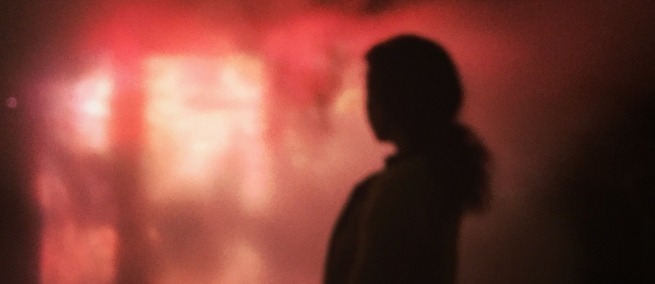
In November of 1979, the Whitney Museum’s patio filled with steam. Projectors spun celluloid which projected 16mm films into the steam, which was thick enough to act as a screen for the projected images. Visitors were encouraged to walk through the screens, and told that they wouldn’t be burned. “Steam Screens” was a collaboration between the artists Stan VanDerBeek and Joan Brigham. This 1979 installation was reprised on November 20, 2016, at the Knockdown Center in Maspeth, New York, by the Whitney Museum and Microscope Gallery as part of the exhibition Dreamlands: Immersive Cinema and Art, 1905-2016.
Stan VanDerBeek was one of the pioneers of computer art. Joan Brigham can be considered an environmental engineer, manipulating water condensation for immersive installations. She primarily works with steam. For “Steam Screens,” metal pipes were laid a grid on the gravel of the Knockdown center’s courtyard. Brigham used the same piping factor as contributed to the original performance–Mobile Steam–which is located at 182 Montrose Avenue, down the block from Knockdown. A selection of 16mm films by the Stan VanDerBeek were projected onto waterfalls of steam, so dense that images from the three projectors placed around the space could be discerned before blowing away in the wind.
In the MIT journal Leonardo in 1977, Joan Brigham wrote that, “where the control valves [of the iron pipes] are opened, the hot vapor passes through the pipe system and issues out through the small holes. On passage from the pipes through these openings to the ambient air, the vapor suffers a drop in pressure. This change in pressure causes an immediate expansion of the vapor together with a drop in its temperature. Condensation occurs forming a visible mist. The greater the difference between the temperature inside and outside the pipes, the more voluminous the escaping steam will appear. Thus steam works are particularly suited for viewing during cold weather.” November 20 was a gusty evening, and the day before the first snow of the season.
The film projected in “Steam Screens” was made by VanDerBeek in 1979 while he was an artist-in-residence at NASA’s Space Center in Houston, Texas. Called EUCLIDEAN ILLUSIONS, it consists of geometric shapes in various colors, animated with the help of Richard Weinberg and set to music composed by VanDerBeek’s brother, Max. “Steam Screens” takes the notion of 3D film into the fourth dimension; viewers can walk through the steam to be engulfed in the film.
The exhibition of which “Steam Screens” is a part, Dreamlands, frames different moving image works as immersive. The floor of one room at the Whitney is covered in filmstrips which visitors can wade through, examine, throw into the air, or tear up. Another installation is best experienced while sitting on the floor, between four screens on walls backlit by pink fluorescents. Fake oranges to juggle, throw, or with which a viewer can roll around cover the floor.
Dreamlands is curated by Chrissie Iles. Dreamlands: Expanded is a series of expanded cinema events organized by Microscope Gallery in collaboration with the Whitney Museum as part of the exhibition. Microscope Gallery, run by Andrea Monti and Elle Burchill, presents works in all mediums with an emphasis on moving image, sound, performance, and digital art run. Dreamlands is up at the Whitney through February 5, 2017. For more, Science & Film interviewed Iles about the exhibition, and selected various screening programs to highlight.
The films of Stan VanDerBeek have been exhibited at Museum of the Moving Image as part of an exhibition “Computer Films of the 1960s.” VanDerBeek was part of a membership organization called Experiments in Art and Technology, which paired artists with engineers from Bell Laboratories.